From Feudalism to Capitalism From Ottoman to Turkey (I)
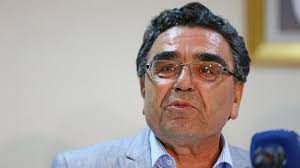
oguz oyan
We are faced with a magnificent work, which was prepared in France as a doctoral thesis in 1978 by Oğuz Oyan, and which criticizes the ATÜT debate, which the Turkish economic community attaches great importance to after 1960, as a result, trying to explain why the Ottoman Empire did not (did not) become (later) capitalist. . The translation of the book into Turkish in 2016 (the author participates in these discussions through his articles in the 80s and 90s) is seen as a serious loss for those who work in the history of Ottoman economics. Our teacher directs us to read primary sources by sending constant references to the legendary professors of the Istanbul Faculty of Economics (he studied during the 1965-1969 period). Apart from this, scientists who have made original contributions to Ottoman history, both in political and economic matters, and in the field of culture and civilization history, are hailed.
İdris KÜÇÜKÖMER,
Sencer DIVITCIOGLU,
Omer Lutfi BARKAN,
Mustafa AKDAG,
Halil INALCIK…….
Our teacher puts the question of why the Ottomans could not become capitalists at the center of his book. Thinking that the answer to this question is in the period of the Ottoman Empire, which we call the classical age, he concentrates all his analysis on this period. 3.5 years of the 4.5-year thesis work was spent only for this section. Professional economist Oğuz Oyan clearly states in the preface of the book that he does not see the events like a historian. analysis of Ottoman society; relations of production and production form/style are examined (following the Marxist method) and other superstructure formations are also mentioned.
The book consists of 3 main parts:
The dominant mode of production in Ottoman society before the 1st-16th centuries
2-The dissolution and transformation of the Ottoman agricultural regime (Structural Limits of Evolution to Capitalism)
3-Capitalism entry into Ottoman agriculture under external influences
The dominant mode of production in Ottoman society before the 16th century
The main features of the Ottoman agricultural regime
The first part of the book begins the whole story by describing the main features of the Ottoman agricultural regime. When we say the Ottoman agricultural regime, we come across the dirlik regime. In the system we call the Miri land regime, the bare ownership of the land belongs to the sultan (state). Soils are simply divided into three. Has, Zeamet and grooming. Oğuz OYAN not only prepares the foundations of ATÜT criticism, but also tries to reach the definition of “feudalism type” for the ottoman by analyzing the reaya and the timarli cavalrymen within this system.
Reaya respectively; He earned the right to save the land by paying the “deed official” to the sipahi. In addition, if he did not produce the necessary production under the double taxation tax or left his land, he paid a separate tax to the sipahi. Apart from this, it is clearly emphasized that there are arbitrary releases in free fiefs. When Reaya passed away, the land passed directly to his son. Here, reaya land has only the right of disposal and no personal ownership.

From Feudalism to Capitalism, From Ottomans to Turkey Oguz Oyan page 56
Our teacher used the definition of “hereditary tenant” here. It’s a nice naming.
An important detail for me is mentioned here on page 57. When Reaya built new structures in the fields of his farm in the sense of vineyard or garden, he directly owned a property of his own. According to the statement received from Akdağ, these properties could be subject to sale. As you can guess, the purpose of the state i aliyya to give this was tax. 🙂
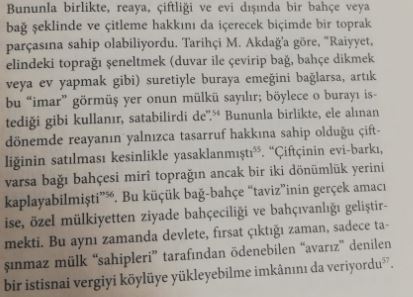
From Feudalism to Capitalism, From Ottomans to Turkey Oguz Oyan page 57
Halil İnalcık (I cannot give a reference) considered the grooming relationship to be the most optimal solution of his time. On the one hand, the production on the land continues continuously, the authority to monitor and supervise this continuation is given to the sipahi, and the money to be paid to the sipahi is paid in kind through this system.
ASIAN PRODUCTION STYLE
Oğuz Oyan puts Divitçioğlu teacher in the center and criticizes him from these pages. We all know that Divitçioğlu started to be interested in the ATÜT thesis after he met Kemal Tahir. (Economics Documentary in Istanbul-Çiğdem BOZ)
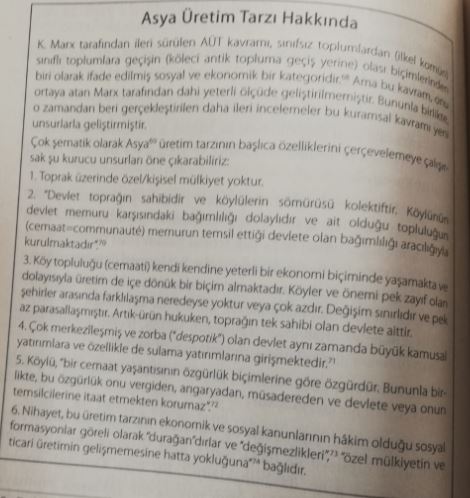
From Feudalism to Capitalism, From Ottomans to Turkey Oguz Oyan page 62
Our teacher Cüneyt AKMAN says that the ATUT debate is a waste of time for our country, every time a topic is brought up. 🙂 I’m 42 years old too, the ATÜT discussion enjoyed it while waiting for GODOT. For this reason, I will not include the ATUT discussion at length on this page.
You just need to know this.
A central state body directly appropriates the surplus, and some of the same surplus is spent on social affairs (large public works). There is no private or personal property. Marx sees ATUT as the closest system (Formen) to communal community organization.
The details that Oğuz Oyan especially emphasized;
Reayan’s attachment to the land was similar to that of the feudal regime, although there were some softening elements.
Raiyet could not easily change class, (Raiyet cannot use weapons and horses)
Sipahi was not a simple tax collector,
Apart from levying taxes (free fiefs), the sipahi had other similar features to the feudal lords.
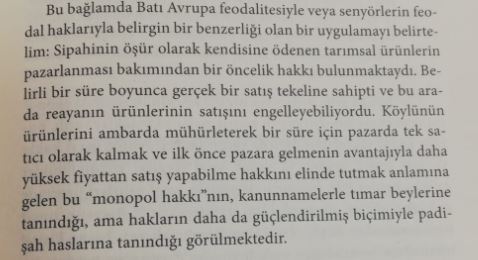
From Feudalism to Capitalism, From Ottomans to Turkey Oguz Oyan page 73
Over large areas, the sultan’s (state) non-de facto superior ownership and the more direct ownership of small and medium-sized (especially free timar) cavalry and the provisional right of disposition.
Although the central authority on the basis of ATUT made large irrigation investments (or public investments), these investments were carried out through foundations in the Ottoman Empire.
In the Ottoman Empire, there was an independent land ownership indirectly from the state through foundation and property lands. Fatih wanted to add these lands to the miri land, we all know the result.
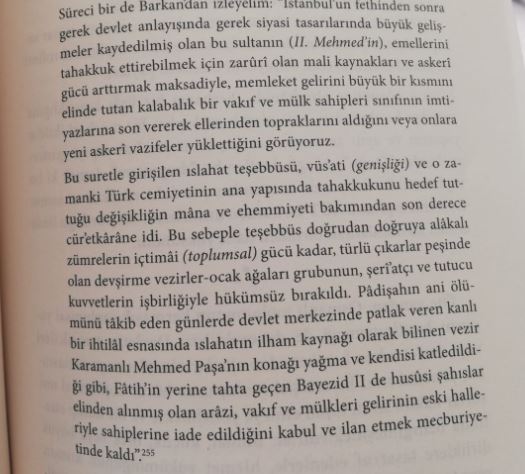
From Feudalism to Capitalism, From Ottomans to Turkey Oguz Oyan page 125
As can be seen, all the powers whose interests have been in conflict for half a century have not united and gave up their lands in order not to lose their assets.
The transfer of timars from father to son had been regulated yet in 1376, and its restriction would only be possible at the beginning of the 16th century. The author reports that family nobility continued in Ottoman society despite the restrictions. He also claims, on pages 84-87, that grooming is seriously, if not directly, subject to sale.
The entrance of the Kapıkulları to the stage begins in the middle of the 14th century and reaches its peak with the half-hill rebellion. A new partner emerges from the surplus in the Ottoman Empire.
Based on Barkan’s 1527-1528 data, it is now added that 60 percent of the product is owned by powers other than the central government.
In order to emphasize private property in the Ottoman Empire, exceptions to the miri system are listed on page 111.
These are, in order:
Homosexual estates/property grooming
freehold properties
Mansion-i Divani
Öşri and external lands
foundation properties
sorted as.
The part where the urban and rural debate begins is an oasis for Ottoman economic historians to read very important findings. Starting with Marx’s thesis that city and country do not differentiate, it is stated that this is not valid in the Ottoman Empire. Afterwards, the differentiation between urban and rural areas in the transition from feudalism to capitalism is explained theoretically and the situation of the Ottoman Empire is determined.
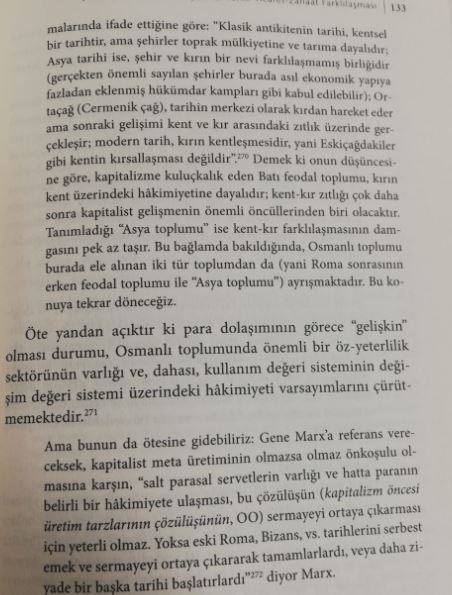
From Feudalism to Capitalism, From Ottomans to Turkey Oguz Oyan page 133
Akdağ Hodja’s writings on the establishment of illegal farms in the first half of the 16th century are included, and it is concluded that there was production on large feudal properties in the Ottoman countryside. It is worth remembering that this was made for the palace and the inner market.
Returning to the urban and rural issue, I would like to remind you that it is one-sided.
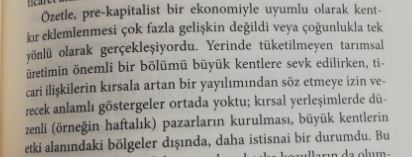
From Feudalism to Capitalism, From Ottoman to Turkey Oguz Oyan page 143
As the conflict between rural and urban areas accelerates in Europe, cities are becoming increasingly autonomous and paving the way for capitalism. So what’s going on in the ottoman?
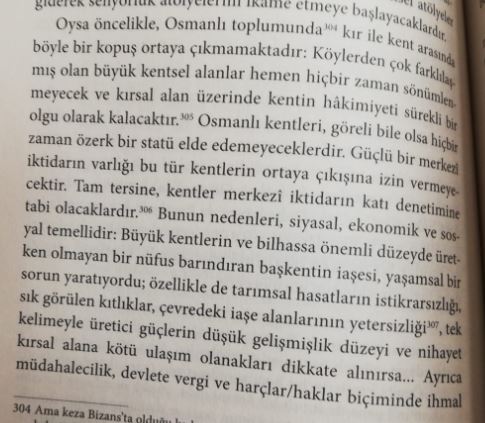
From Feudalism to Capitalism, From Ottomans to Turkey Oguz Oyan page 146
On the contrary, cities remain under the strict control of the central government.
Guild structure and foreign trade
We conclude this section by continuing with the guild structure and foreign trade.
As we all know, guilds are introverted structures that are difficult to enter. Here, the state puts pressure on these structures and causes them to withdraw into themselves. As long as these structures exist, it becomes difficult for direct producers to transform into capitalist producers.
The fact that the development of the division of labor was interrupted by the intervention of the state on the one hand and insufficient technology on the other, strengthened the influence of external influences (foreign powers) on the Ottoman Empire.
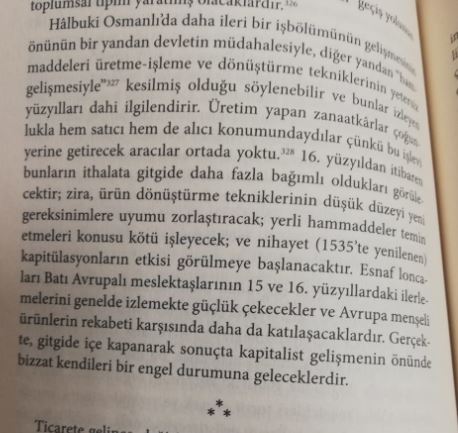
From Feudalism to Capitalism, From Ottoman to Turkey Oguz Oyan page 152
I really liked that sentence.
“They will become more and more introverted and eventually become themselves an obstacle to capitalist development”.
As for foreign trade, the goods produced by the reaya were in serious demand from abroad, and the state wanted to stop this flow. We should point out that it was unsuccessful. We should also note that most of the foreign trade is in the hands of foreigners, and there is no local bourgeoisie who can carry out long-distance trade. The state is both monopsony and monopoly, trying to collect taxes at all stages of exchange, while foreigners try to buy goods from royalty at higher prices. Knowing that the endless series of problems encourage smuggling, not production. 🙂
While the existing structure in Europe is trying to pave the way for primitive accumulation and commercial capital, while mercantilist methods are followed, this is not observed in the Ottoman Empire.
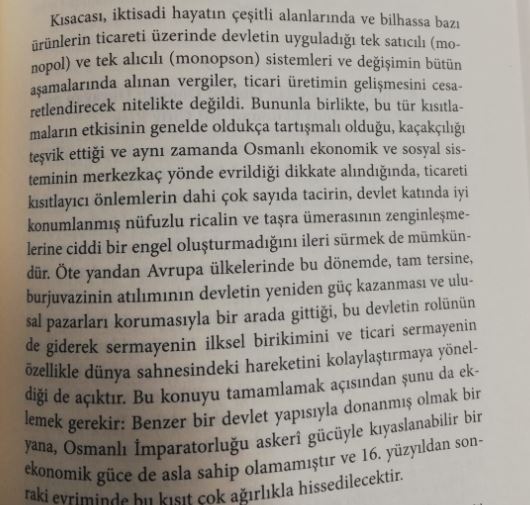
From Feudalism to Capitalism, From Ottomans to Turkey Oguz Oyan page 155
END OF Chapter
Be sure to read our teacher’s footnotes.

From Feudalism to Capitalism, From Ottoman to Turkey Oguz Oyan page 156
In this chapter; The descriptions of Behice Boran, Muzaffer Erdost, Niyazi Berkes, Behice Boran, Halil İnalcık and Barkan on the subject are given.
On page 166, it is stated that the Ottoman socioeconomic system is a type of feudalism. On Footnote 380, it is stated that ATÜT is not unimportant, but it is more appropriate to use the concept of proto-feudal mode of production instead.
It is stated that Engels first defined ATÜT and then the “semi-feudal Turkish system” (page 168).
Our teacher claims that the reason for the delay in the capitalist mode of production in the Ottoman Empire was that the Ottomans had a different type of feudalism. The lagging elements of this society are partly inherent in the characteristics of its central structure and partly in the processes of blockage of primary capital accumulation (external influences appear second).
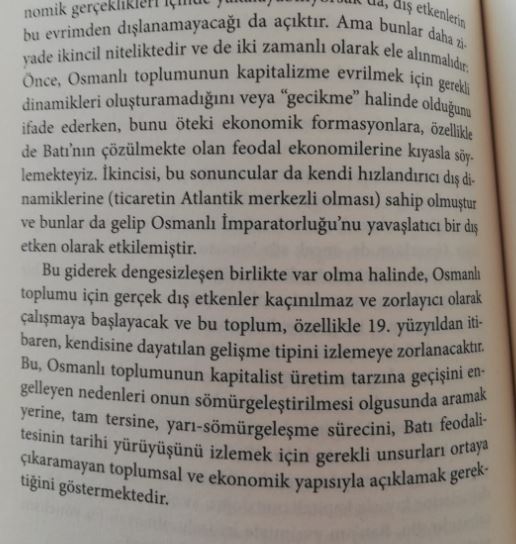
From Feudalism to Capitalism, From Ottomans to Turkey Oguz Oyan page 174
Associate Professor Data Man







